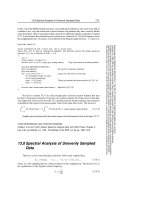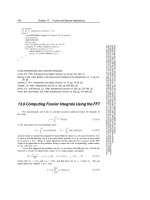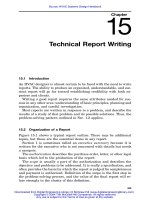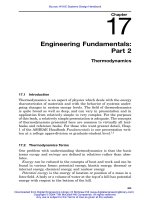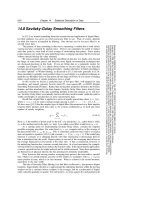Tài liệu Fourier and Spectral Applications part 7 pptx
Bạn đang xem bản rút gọn của tài liệu. Xem và tải ngay bản đầy đủ của tài liệu tại đây (172.52 KB, 9 trang )
564
Chapter 13. Fourier and Spectral Applications
Sample page from NUMERICAL RECIPES IN C: THE ART OF SCIENTIFIC COMPUTING (ISBN 0-521-43108-5)
Copyright (C) 1988-1992 by Cambridge University Press.Programs Copyright (C) 1988-1992 by Numerical Recipes Software.
Permission is granted for internet users to make one paper copy for their own personal use. Further reproduction, or any copying of machine-
readable files (including this one) to any servercomputer, is strictly prohibited. To order Numerical Recipes books,diskettes, or CDROMs
visit website or call 1-800-872-7423 (North America only),or send email to (outside North America).
for specific situations, and arm themselves with a variety of other tricks. We suggest that
you do likewise, as your projects demand.
CITED REFERENCES AND FURTHER READING:
Hamming, R.W. 1983,
Digital Filters
, 2nd ed. (Englewood Cliffs, NJ: Prentice-Hall).
Antoniou, A. 1979,
Digital Filters: Analysis and Design
(New York: McGraw-Hill).
Parks, T.W., and Burrus, C.S. 1987,
Digital Filter Design
(New York: Wiley).
Oppenheim, A.V., and Schafer, R.W. 1989,
Discrete-Time Signal Processing
(Englewood Cliffs,
NJ: Prentice-Hall).
Rice, J.R. 1964,
The Approximation of Functions
(Reading, MA: Addison-Wesley); also 1969,
op. cit.
,Vol.2.
Rabiner, L.R., and Gold, B. 1975,
Theory and Application of Digital Signal Processing
(Englewood
Cliffs, NJ: Prentice-Hall).
13.6 Linear Prediction and Linear Predictive
Coding
We begin with a very general formulation that will allow us to make connections
to various special cases. Let {y
α
} be a set of measured values for some underlying
set of true values of a quantity y, denoted {y
α
}, related to these true values by
the addition of random noise,
y
α
= y
α
+ n
α
(13.6.1)
(compare equation 13.3.2, with a somewhat different notation). Our use of a Greek
subscript to index the members of the set is meant to indicate that the data points
are not necessarily equally spaced along a line, or even ordered: they might be
“random” points in three-dimensional space, for example. Now, suppose we want to
construct the “best” estimate of the true value of some particular point y
as a linear
combination of the known, noisy, values. Writing
y
=
α
d
α
y
α
+ x
(13.6.2)
we want to find coefficients d
α
that minimize, in some way, thediscrepancy x
.The
coefficients d
α
have a “star” subscript to indicate that they depend on the choice of
point y
. Later, we might want to let y
be one of the existing y
α
’s. In that case,
our problem becomes one of optimal filtering or estimation, closely related to the
discussion in §13.3. On the other hand, we might want y
to be a completely new
point. In that case, our problem will be one of linear prediction.
A natural way to minimize the discrepancy x
is in the statistical mean square
sense. If angle brackets denote statistical averages, then we seek d
α
’s that minimize
x
2
=
α
d
α
(y
α
+ n
α
) − y
2
=
αβ
(y
α
y
β
+ n
α
n
β
)d
α
d
β
− 2
α
y
y
α
d
α
+
y
2
(13.6.3)
13.6 Linear Prediction and Linear Predictive Coding
565
Sample page from NUMERICAL RECIPES IN C: THE ART OF SCIENTIFIC COMPUTING (ISBN 0-521-43108-5)
Copyright (C) 1988-1992 by Cambridge University Press.Programs Copyright (C) 1988-1992 by Numerical Recipes Software.
Permission is granted for internet users to make one paper copy for their own personal use. Further reproduction, or any copying of machine-
readable files (including this one) to any servercomputer, is strictly prohibited. To order Numerical Recipes books,diskettes, or CDROMs
visit website or call 1-800-872-7423 (North America only),or send email to (outside North America).
Here we have used the fact that noise is uncorrelated with signal, e.g., n
α
y
β
=0.
The quantities y
α
y
β
and y
y
α
describe the autocorrelation structure of the
underlying data. We have already seen an analogous expression, (13.2.2), for the
case of equally spaced data points on a line; we will meet correlation several times
againinitsstatisticalsense inChapters14and15. Thequantitiesn
α
n
β
describe the
autocorrelation properties of the noise. Often, for point-to-pointuncorrelated noise,
we have n
α
n
β
=
n
2
α
δ
αβ
. It is convenient to think of the various correlation
quantities as comprising matrices and vectors,
φ
αβ
≡y
α
y
β
φ
α
≡y
y
α
η
αβ
≡n
α
n
β
or
n
2
α
δ
αβ
(13.6.4)
Setting the derivative of equation (13.6.3) with respect to the d
α
’s equal to zero,
one readily obtains the set of linear equations,
β
[φ
αβ
+ η
αβ
] d
β
= φ
α
(13.6.5)
If we write the solution as a matrix inverse, then the estimation equation (13.6.2)
becomes, omitting the minimized discrepancy x
,
y
≈
αβ
φ
α
[φ
µν
+ η
µν
]
−1
αβ
y
β
(13.6.6)
From equations(13.6.3)and (13.6.5) one can alsocalculate theexpected mean square
value of the discrepancy at its minimum, denoted
x
2
0
,
x
2
0
=
y
2
−
β
d
β
φ
β
=
y
2
−
αβ
φ
α
[φ
µν
+ η
µν
]
−1
αβ
φ
β
(13.6.7)
A final general result tells how much the mean square discrepancy
x
2
is
increased if we use the estimation equation (13.6.2) not with the best values d
β
, but
with some other values
d
β
. The above equations then imply
x
2
=
x
2
0
+
αβ
(
d
α
− d
α
)[φ
αβ
+ η
αβ
](
d
β
− d
β
)(13.6.8)
Since the second term is a pure quadratic form, we see that the increase in the
discrepancy is only second order in any error made in estimating the d
β
’s.
Connection to Optimal Filtering
If we change “star” to a Greek index, say γ, then the above formulas describe
optimal filtering, generalizing the discussion of §13.3. One sees, for example, that
if the noise amplitudes n
α
go to zero, so likewise do the noise autocorrelations
η
αβ
, and, canceling a matrix times its inverse, equation (13.6.6) simply becomes
y
γ
= y
γ
. Another special case occurs if the matrices φ
αβ
and η
αβ
are diagonal.
In that case, equation (13.6.6) becomes
y
γ
=
φ
γγ
φ
γγ
+ η
γγ
y
γ
(13.6.9)
566
Chapter 13. Fourier and Spectral Applications
Sample page from NUMERICAL RECIPES IN C: THE ART OF SCIENTIFIC COMPUTING (ISBN 0-521-43108-5)
Copyright (C) 1988-1992 by Cambridge University Press.Programs Copyright (C) 1988-1992 by Numerical Recipes Software.
Permission is granted for internet users to make one paper copy for their own personal use. Further reproduction, or any copying of machine-
readable files (including this one) to any servercomputer, is strictly prohibited. To order Numerical Recipes books,diskettes, or CDROMs
visit website or call 1-800-872-7423 (North America only),or send email to (outside North America).
whichis readilyrecognizableas equation (13.3.6)withS
2
→ φ
γγ
,N
2
→ η
γγ
.What
is going on is this: For the case of equally spaced data points, and in the Fourier
domain, autocorrelations become simply squares of Fourier amplitudes (Wiener-
Khinchin theorem, equation 12.0.12), and the optimal filter can be constructed
algebraically, as equation (13.6.9), without inverting any matrix.
More generally, in the time domain, or any other domain, an optimal filter (one
that minimizes the square of the discrepancy from the underlying true value in the
presence of measurement noise) can be constructed by estimating the autocorrelation
matrices φ
αβ
and η
αβ
, and applying equation (13.6.6) with → γ. (Equation
13.6.8 is in fact the basis for the §13.3’s statement that even crude optimal filtering
can be quite effective.)
Linear Prediction
Classical linear prediction specializes to the case where the data points y
β
are equally spaced along a line, y
i
, i =1,2, ,N, and we want to use M
consecutive values of y
i
to predict an M +1st. Stationarity is assumed. That is, the
autocorrelation y
j
y
k
is assumed to depend only on the difference |j − k|, and not
on j or k individually, so that the autocorrelation φ has only a single index,
φ
j
≡y
i
y
i+j
≈
1
N−j
N−j
i=1
y
i
y
i+j
(13.6.10)
Here, the approximate equality shows one way to use the actual data set values to
estimate the autocorrelationcomponents. (In fact, there isa better way to make these
estimates; see below.) In the situation described, the estimation equation (13.6.2) is
y
n
=
M
j=1
d
j
y
n−j
+ x
n
(13.6.11)
(compare equation 13.5.1) and equation (13.6.5) becomes the set of M equations for
the M unknown d
j
’s, now called the linear prediction (LP) coefficients,
M
j=1
φ
|j−k|
d
j
= φ
k
(k =1, ,M)(13.6.12)
Notice that while noise is not explicitly included in the equations, it is properly
accounted for, if it is point-to-point uncorrelated: φ
0
, as estimated by equation
(13.6.10)usingmeasured valuesy
i
, actuallyestimatesthediagonalpart ofφ
αα
+η
αα
,
above. The mean square discrepancy
x
2
n
is estimated by equation (13.6.7) as
x
2
n
= φ
0
− φ
1
d
1
− φ
2
d
2
−···−φ
M
d
M
(13.6.13)
To use linear prediction, we first compute the d
j
’s, using equations (13.6.10)
and (13.6.12). We then calculate equation (13.6.13) or, more concretely, apply
(13.6.11) to the known record to get an idea of how large are the discrepancies x
i
.
If the discrepancies are small, then we can continue applying (13.6.11) right on into
13.6 Linear Prediction and Linear Predictive Coding
567
Sample page from NUMERICAL RECIPES IN C: THE ART OF SCIENTIFIC COMPUTING (ISBN 0-521-43108-5)
Copyright (C) 1988-1992 by Cambridge University Press.Programs Copyright (C) 1988-1992 by Numerical Recipes Software.
Permission is granted for internet users to make one paper copy for their own personal use. Further reproduction, or any copying of machine-
readable files (including this one) to any servercomputer, is strictly prohibited. To order Numerical Recipes books,diskettes, or CDROMs
visit website or call 1-800-872-7423 (North America only),or send email to (outside North America).
the future, imagining the unknown “future” discrepancies x
i
to be zero. In this
application, (13.6.11) is a kind of extrapolation formula. In many situations, this
extrapolationturnsoutto be vastlymorepowerfulthanany kindofsimplepolynomial
extrapolation. (By the way, you should not confuse the terms “linear prediction”and
“linear extrapolation”; the general functional form used by linear prediction is much
more complex than a straight line, or even a low-order polynomial!)
However, to achieve its full usefulness, linear prediction must be constrained in
one additional respect: One must take additional measures to guarantee its stability.
Equation (13.6.11) is a special case of the general linear filter (13.5.1). The condition
that (13.6.11) be stable as a linear predictor is precisely that given in equations
(13.5.5) and (13.5.6), namely that the characteristic polynomial
z
N
−
N
j=1
d
j
z
N−j
=0 (13.6.14)
have all N of its roots inside the unit circle,
|z|≤1(13.6.15)
There is no guarantee that the coefficients produced by equation (13.6.12) will have
this property. If the data contain many oscillations without any particular trend
towards increasing or decreasing amplitude, then the complex roots of (13.6.14)
will generally all be rather close to the unit circle. The finite length of the data
set will cause some of these roots to be inside the unit circle, others outside. In
some applications, where the resulting instabilitiesare slowly growing and the linear
prediction is not pushed too far, it is best to use the “unmassaged” LP coefficients
that come directly out of (13.6.12). For example, one might be extrapolating to fill a
short gap in a data set; then one might extrapolate both forwards across the gap and
backwards from the data beyond the gap. If the two extrapolations agree tolerably
well, then instability is not a problem.
When instability is a problem, you have to “massage” the LP coefficients. You
do this by (i) solving (numerically) equation (13.6.14) for its N complex roots; (ii)
moving the roots to where you think they ought to be inside or on the unit circle; (iii)
reconstitutingthe now-modified LP coefficients. You may think that step (ii) sounds
a little vague. It is. There is no “best” procedure. If you think that your signal
is truly a sum of undamped sine and cosine waves (perhaps with incommensurate
periods), then you will want simply to move each root z
i
onto the unit circle,
z
i
→ z
i
/ |z
i
| (13.6.16)
In other circumstances it may seem appropriate to reflect a bad root across the
unit circle
z
i
→ 1/z
i
*(13.6.17)
This alternative has the property that it preserves the amplitude of the output of
(13.6.11) when it is driven by a sinusoidal set of x
i
’s. It assumes that (13.6.12)
has correctly identified the spectral width of a resonance, but only slipped up on
568
Chapter 13. Fourier and Spectral Applications
Sample page from NUMERICAL RECIPES IN C: THE ART OF SCIENTIFIC COMPUTING (ISBN 0-521-43108-5)
Copyright (C) 1988-1992 by Cambridge University Press.Programs Copyright (C) 1988-1992 by Numerical Recipes Software.
Permission is granted for internet users to make one paper copy for their own personal use. Further reproduction, or any copying of machine-
readable files (including this one) to any servercomputer, is strictly prohibited. To order Numerical Recipes books,diskettes, or CDROMs
visit website or call 1-800-872-7423 (North America only),or send email to (outside North America).
identifyingits time sense so that signals that should be damped as time proceeds end
up growing in amplitude. The choice between (13.6.16) and (13.6.17) sometimes
might as well be based on voodoo. We prefer (13.6.17).
Also magical is the choice of M , the number of LP coefficients to use. You
should choose M to be as small as works for you, that is, you should choose it by
experimenting with your data. Try M =5,10, 20, 40. If you need larger M ’s than
this, be aware that the procedure of “massaging” all those complex roots is quite
sensitive to roundoff error. Use double precision.
Linear prediction is especially successful at extrapolatingsignals that are smooth
and oscillatory,thoughnotnecessarily periodic. In such cases, linear prediction often
extrapolates accurately through many cycles of the signal. By contrast, polynomial
extrapolation in general becomes seriously inaccurate after at most a cycle or two.
A prototypical example of a signal that can successfully be linearly predicted is the
height of ocean tides, for which the fundamental 12-hour period is modulated in
phase and amplitude over the course of the month and year, and for which local
hydrodynamic effects may make even one cycle of the curve look rather different
in shape from a sine wave.
We already remarked that equation (13.6.10) is not necessarily the best way
to estimate the covariances φ
k
from the data set. In fact, results obtained from
linear prediction are remarkably sensitive to exactly how the φ
k
’s are estimated.
One particularly good method is due to Burg
[1]
, and involves a recursive procedure
for increasing the order M by one unit at a time, at each stage re-estimating the
coefficients d
j
, j =1, ,M so as to minimize the residual in equation (13.6.13).
Althoughfurtherdiscussionof theBurgmethodis beyondourscope here, themethod
is implemented in the following routine
[1,2]
for estimating the LP coefficients d
j
ofadataset.
#include <math.h>
#include "nrutil.h"
void memcof(float data[], int n, int m, float *xms, float d[])
Given a real vector of
data[1 n],andgivenm, this routine returns m linear prediction coef-
ficients as
d[1 m], and returns the mean square discrepancy as xms.
{
int k,j,i;
float p=0.0,*wk1,*wk2,*wkm;
wk1=vector(1,n);
wk2=vector(1,n);
wkm=vector(1,m);
for (j=1;j<=n;j++) p += SQR(data[j]);
*xms=p/n;
wk1[1]=data[1];
wk2[n-1]=data[n];
for (j=2;j<=n-1;j++) {
wk1[j]=data[j];
wk2[j-1]=data[j];
}
for (k=1;k<=m;k++) {
float num=0.0,denom=0.0;
for (j=1;j<=(n-k);j++) {
num += wk1[j]*wk2[j];
denom += SQR(wk1[j])+SQR(wk2[j]);
}
d[k]=2.0*num/denom;
13.6 Linear Prediction and Linear Predictive Coding
569
Sample page from NUMERICAL RECIPES IN C: THE ART OF SCIENTIFIC COMPUTING (ISBN 0-521-43108-5)
Copyright (C) 1988-1992 by Cambridge University Press.Programs Copyright (C) 1988-1992 by Numerical Recipes Software.
Permission is granted for internet users to make one paper copy for their own personal use. Further reproduction, or any copying of machine-
readable files (including this one) to any servercomputer, is strictly prohibited. To order Numerical Recipes books,diskettes, or CDROMs
visit website or call 1-800-872-7423 (North America only),or send email to (outside North America).
*xms *= (1.0-SQR(d[k]));
for (i=1;i<=(k-1);i++)
d[i]=wkm[i]-d[k]*wkm[k-i];
The algorithm is recursive, building up the answer for larger and larger values of m
until the desired value is reached. At this point in the algorithm, one could return
the vector d and scalar xms for a set of LP coefficients with k (rather than m)
terms.
if (k == m) {
free_vector(wkm,1,m);
free_vector(wk2,1,n);
free_vector(wk1,1,n);
return;
}
for (i=1;i<=k;i++) wkm[i]=d[i];
for (j=1;j<=(n-k-1);j++) {
wk1[j] -= wkm[k]*wk2[j];
wk2[j]=wk2[j+1]-wkm[k]*wk1[j+1];
}
}
nrerror("never get here in memcof.");
}
Here are procedures for rendering the LP coefficients stable (if you choose to
do so), and for extrapolating a data set by linear prediction, using the original or
massaged LP coefficients. The routine zroots (§9.5) is used to find all complex
roots of a polynomial.
#include <math.h>
#include "complex.h"
#define NMAX 100 Largest expected value of m.
#define ZERO Complex(0.0,0.0)
#define ONE Complex(1.0,0.0)
void fixrts(float d[], int m)
Given the LP coefficients
d[1 m], this routine finds all roots of the characteristic polynomial
(13.6.14), reflects any roots that are outside the unit circle back inside, and then returns a
modified set of coefficients
d[1 m].
{
void zroots(fcomplex a[], int m, fcomplex roots[], int polish);
int i,j,polish;
fcomplex a[NMAX],roots[NMAX];
a[m]=ONE;
for (j=m-1;j>=0;j ) Set up complex coefficients for polynomial root
finder.a[j]=Complex(-d[m-j],0.0);
polish=1;
zroots(a,m,roots,polish); Find all the roots.
for (j=1;j<=m;j++) Look for a
if (Cabs(roots[j]) > 1.0) root outside the unit circle,
roots[j]=Cdiv(ONE,Conjg(roots[j])); and reflect it back inside.
a[0]=Csub(ZERO,roots[1]); Now reconstruct the polynomial coefficients,
a[1]=ONE;
for (j=2;j<=m;j++) { by looping over the roots
a[j]=ONE;
for (i=j;i>=2;i ) and synthetically multiplying.
a[i-1]=Csub(a[i-2],Cmul(roots[j],a[i-1]));
a[0]=Csub(ZERO,Cmul(roots[j],a[0]));
}
for (j=0;j<=m-1;j++) The polynomial coefficients are guaranteed to be
real, so we need only return the real part as
new LP coefficients.
d[m-j] = -a[j].r;
}
570
Chapter 13. Fourier and Spectral Applications
Sample page from NUMERICAL RECIPES IN C: THE ART OF SCIENTIFIC COMPUTING (ISBN 0-521-43108-5)
Copyright (C) 1988-1992 by Cambridge University Press.Programs Copyright (C) 1988-1992 by Numerical Recipes Software.
Permission is granted for internet users to make one paper copy for their own personal use. Further reproduction, or any copying of machine-
readable files (including this one) to any servercomputer, is strictly prohibited. To order Numerical Recipes books,diskettes, or CDROMs
visit website or call 1-800-872-7423 (North America only),or send email to (outside North America).
#include "nrutil.h"
void predic(float data[], int ndata, float d[], int m, float future[],
int nfut)
Given
data[1 ndata], and given the data’s LP coefficients d[1 m], this routine ap-
plies equation (13.6.11) to predict the next
nfut data points, which it returns in the array
future[1 nfut]. Note that the routine references only the last m values of data,asinitial
values for the prediction.
{
int k,j;
float sum,discrp,*reg;
reg=vector(1,m);
for (j=1;j<=m;j++) reg[j]=data[ndata+1-j];
for (j=1;j<=nfut;j++) {
discrp=0.0;
This is where you would put in a known discrepancy if you were reconstructing a
function by linear predictive coding rather than extrapolating a function by linear pre-
diction. See text.
sum=discrp;
for (k=1;k<=m;k++) sum += d[k]*reg[k];
for (k=m;k>=2;k ) reg[k]=reg[k-1]; [If you want to implement circular
arrays, you can avoid this shift-
ing of coefficients.]
future[j]=reg[1]=sum;
}
free_vector(reg,1,m);
}
Removing the Bias in Linear Prediction
You might expect that the sum of the d
j
’s in equation (13.6.11) (or, more
generally, in equation 13.6.2) should be 1, so that (e.g.) adding a constant to all the
data points y
i
yields a prediction that is increased by the same constant. However,
the d
j
’s do not sum to 1 but, in general, to a value slightly less than one. This fact
reveals a subtle point, that the estimator of classical linear prediction is notunbiased,
even though it does minimize the mean square discrepancy. At any place where the
measured autocorrelation does not imply a better estimate, the equations of linear
prediction tend to predict a value that tends towards zero.
Sometimes, that is just what you want. If the process that generates the y
i
’s
in fact has zero mean, then zero is the best guess absent other information. At
other times, however, this behavior is unwarranted. If you have data that show
only small variations around a positive value, you don’t want linear predictions
that droop towards zero.
Often it is a workable approximation to subtract the mean off your data set,
perform the linear prediction, and then add the mean back. This procedure contains
the germ of the correct solution; but the simple arithmetic mean is not quite the
correct constant to subtract. In fact, an unbiased estimator is obtained by subtracting
from every data point an autocorrelation-weighted mean defined by
[3,4]
y ≡
β
[φ
µν
+ η
µν
]
−1
αβ
y
β
αβ
[φ
µν
+ η
µν
]
−1
αβ
(13.6.18)
With this subtraction, the sum of the LP coefficients should be unity, up to roundoff
and differences in how the φ
k
’s are estimated.
13.6 Linear Prediction and Linear Predictive Coding
571
Sample page from NUMERICAL RECIPES IN C: THE ART OF SCIENTIFIC COMPUTING (ISBN 0-521-43108-5)
Copyright (C) 1988-1992 by Cambridge University Press.Programs Copyright (C) 1988-1992 by Numerical Recipes Software.
Permission is granted for internet users to make one paper copy for their own personal use. Further reproduction, or any copying of machine-
readable files (including this one) to any servercomputer, is strictly prohibited. To order Numerical Recipes books,diskettes, or CDROMs
visit website or call 1-800-872-7423 (North America only),or send email to (outside North America).
Linear Predictive Coding (LPC)
A different, though related, method to which the formalism above can be
applied is the “compression” of a sampled signal so that it can be stored more
compactly. The original form should be exactly recoverable from the compressed
version. Obviously, compression can be accomplished only if there is redundancy
in the signal. Equation (13.6.11) describes one kind of redundancy: It says that
the signal, except for a small discrepancy, is predictable from its previous values
and from a small number of LP coefficients. Compression of a signal by the use of
(13.6.11) is thus called linear predictive coding,orLPC.
The basic idea of LPC (in its simplest form) is to record as a compressed file (i)
the number of LP coefficients M, (ii) their M values, e.g., as obtained by memcof,
(iii) the first M data points, and then (iv) for each subsequent data point only its
residual discrepancy x
i
(equation 13.6.1). When you are creating the compressed
file, you find the residual by applying (13.6.1) to the previous M points, subtracting
the sum from the actual value of the current point. When you are reconstructing the
originalfile, youaddtheresidualback in, atthepointindicatedintheroutinepredic.
It may not be obvious why there is any compression at all in this scheme. After
all,we are storingone value of residual per data point! Why not just store the original
data point? The answer depends on the relative sizes of the numbers involved. The
residual is obtained by subtracting two very nearly equal numbers (the data and the
linear prediction). Therefore, the discrepancy typicallyhas only a very small number
of nonzero bits. These can be stored in a compressed file. How do you do it in a
high-level language? Here is one way: Scale your data to have integer values, say
between +1000000 and −1000000 (supposing that you need six significant figures).
Modify equation (13.6.1) by enclosing the sum term in an “integer part of” operator.
The discrepancy will now, by definition, be an integer. Experiment with different
values of M, to find LP coefficients that make the range of the discrepancy as small
as you can. If youcan get to withina range of ±127 (and in our experience thisis not
at all difficult) then you can write it to a file as a single byte. This is a compression
factor of 4, compared to 4-byte integer or floating formats.
Notice that the LP coefficients are computed using the quantized data, and that
the discrepancy is also quantized, i.e., quantization is done both outside and inside
the LPC loop. If you are careful in following this prescription, then, apart from the
initial quantization of the data, you will not introduce even a single bit of roundoff
error into the compression-reconstruction process: While the evaluation of the sum
in (13.6.11) may have roundoff errors, the residual that you store is the value which,
when added back to the sum, gives exactly theoriginal(quantized)data value. Notice
also that you do not need to massage the LP coefficients for stability; by adding the
residual back in to each point, you never depart from the original data, so instabilities
cannot grow. There is therefore no need for fixrts, above.
Look at §20.4 to learn about Huffman coding, which will further compress the
residuals by taking advantage of the fact that smaller values of discrepancy will occur
more often than larger values. A very primitive version of Huffman coding would
be this: If most of the discrepancies are in the range ±127, but an occasional one is
outside,then reserve the value 127 to mean “out ofrange,” and then record on the file
(immediately following the 127) a full-word value of the out-of-range discrepancy.
§20.4 explains how to do much better.
572
Chapter 13. Fourier and Spectral Applications
Sample page from NUMERICAL RECIPES IN C: THE ART OF SCIENTIFIC COMPUTING (ISBN 0-521-43108-5)
Copyright (C) 1988-1992 by Cambridge University Press.Programs Copyright (C) 1988-1992 by Numerical Recipes Software.
Permission is granted for internet users to make one paper copy for their own personal use. Further reproduction, or any copying of machine-
readable files (including this one) to any servercomputer, is strictly prohibited. To order Numerical Recipes books,diskettes, or CDROMs
visit website or call 1-800-872-7423 (North America only),or send email to (outside North America).
There are many variant procedures that all fall under the rubric of LPC.
• If the spectral character of the data is time-variable, then it is best not
to use a single set of LP coefficients for the whole data set, but rather
to partition the data into segments, computing and storing different LP
coefficients for each segment.
• If the data are really well characterized by their LP coefficients, and you
can toleratesome small amount of error, then don’t bother storingall of the
residuals. Just do linear predictionuntilyou are outside of tolerances, then
reinitialize (using M sequential stored residuals) and continue predicting.
• In some applications, most notably speech synthesis, one cares only about
the spectral content of the reconstructed signal, not the relative phases.
In this case, one need not store any starting values at all, but only the
LP coefficients for each segment of the data. The output is reconstructed
by driving these coefficients with initial conditions consisting of all zeros
except for one nonzero spike. A speech synthesizer chip may have of
order 10 LP coefficients, which change perhaps 20 to 50 times per second.
• Some people believe that it is interesting to analyze a signal by LPC, even
when the residuals x
i
are not small. The x
i
’s are then interpreted as the
underlying “input signal” which, when filtered through the all-poles filter
defined by the LP coefficients (see §13.7), produces the observed “output
signal.” LPC reveals simultaneously, it is said, the nature of the filter and
theparticular inputthatis drivingit. We are skeptical of theseapplications;
the literature, however, is full of extravagant claims.
CITED REFERENCES AND FURTHER READING:
Childers, D.G. (ed.) 1978,
Modern Spectrum Analysis
(New York: IEEE Press), especially the
paper by J. Makhoul (reprinted from
Proceedings of the IEEE
, vol. 63, p. 561, 1975).
Burg, J.P. 1968, reprinted in Childers, 1978. [1]
Anderson, N. 1974, reprinted in Childers, 1978. [2]
Cressie, N. 1991, in
Spatial Statistics and Digital Image Analysis
(Washington: National Academy
Press). [3]
Press, W.H., and Rybicki, G.B. 1992,
Astrophysical Journal
, vol. 398, pp. 169–176. [4]
13.7 Power Spectrum Estimation by the
Maximum Entropy (All Poles) Method
The FFT is not the only way to estimate the power spectrum of a process, nor is it
necessarily the best way for all purposes. To see how one might devise another method,
let us enlarge our view for a moment, so that it includes not only real frequencies in the
Nyquist interval −f
c
<f<f
c
, but also the entire complex frequency plane. From that
vantage point, let us transform the complex f-plane to a new plane, called the z-transform
plane or z-plane, by the relation
z ≡ e
2πif∆
(13.7.1)
where ∆ is, as usual,the samplinginterval in the time domain. Notice that the Nyquist interval
on the real axis of the f -plane maps one-to-one onto the unit circle in the complex z-plane.
